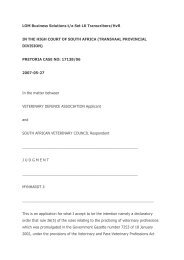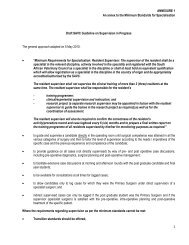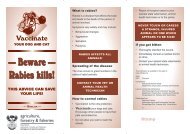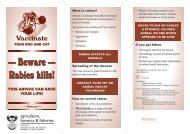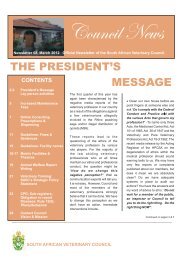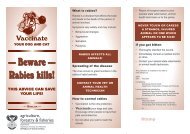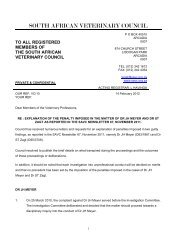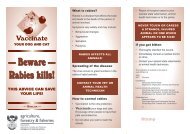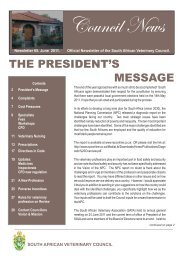Rabies Guide 2010.pdf - the South African Veterinary Council
Rabies Guide 2010.pdf - the South African Veterinary Council
Rabies Guide 2010.pdf - the South African Veterinary Council
You also want an ePaper? Increase the reach of your titles
YUMPU automatically turns print PDFs into web optimized ePapers that Google loves.
36<br />
Fraudulent vaccines, nerve-tissue derived vaccines<br />
and equine immunoglobulin commonly associated<br />
with severe adverse reactions may be used in <strong>the</strong>se<br />
countries. 89 In certain areas tourists are frequently<br />
exposed to dogs, for example a survey of European<br />
travellers in Thailand found that in less than a three<br />
week period 1,3% of tourists experienced dog bites<br />
and 8,9% dog licks. 90 Advantages of pre-exposure<br />
rabies vaccination include requiring only two boosters,<br />
on days 0 and 3, if <strong>the</strong>re is an exposure, no need for<br />
immunoglobulin, and diminished concern about<br />
inadequate <strong>the</strong>rapy and vaccine failure.<br />
Advice and vaccination should be adapted to <strong>the</strong><br />
individual needs and exposure risks of travellers,<br />
taking into account <strong>the</strong> area visited, local rabies<br />
epidemiology, mode of travel, and underlying<br />
medical conditions and medication. Travellers who<br />
are immunocompromised by disease or selected<br />
medications are a group deserving particular attention<br />
as immune response to vaccine may be suboptimal.<br />
They should avoid activities for which rabies preexposure<br />
vaccination is indicated. When this is not<br />
possible, immunocompromised individuals who are<br />
at risk of rabies exposure should be vaccinated and<br />
<strong>the</strong>ir antibody titres checked post-vaccination. 91<br />
Management of humans exposed<br />
to rabies<br />
The death of a person from rabies should be viewed as<br />
a health system failure. This contention is supported<br />
by a review of failed post-exposure prophylaxis in<br />
Thailand, which found that delays, failure to provide<br />
post-exposure prophylaxis or deviations from <strong>the</strong><br />
recommended regimen contributed directly to <strong>the</strong><br />
deaths of young children. 92<br />
Findings from studies in <strong>South</strong> Africa and Thailand have<br />
highlighted deficiencies in health workers’ knowledge<br />
on managing suspected rabies exposures. 49,93<br />
It is <strong>the</strong>refore recommended that a confidential<br />
enquiry routinely be conducted to establish avoidable<br />
factors which may have contributed to <strong>the</strong> death.<br />
Although no controlled human trial of rabies postexposure<br />
prophylaxis utilising wound treatment,<br />
immunoglobulin and vaccination has been conducted<br />
and such a study would be unethical, extensive<br />
global experience provides convincing support for this<br />
approach. 94,95,96<br />
There is a critical need for veterinary and health<br />
workers to be adequately trained on assessing rabies<br />
risk and appropriate response. It is also imperative<br />
that health and veterinary workers involved in<br />
managing human cases with potential exposure to<br />
rabies virus remain in close communication so that<br />
patient management can be modified by data about<br />
<strong>the</strong> source animal. The health worker is obliged to<br />
make contact with <strong>the</strong> responsible state veterinarian.<br />
Laboratory-confirmed human rabies and exposure to<br />
proven rabid animals is notifiable in <strong>South</strong> Africa.<br />
Assessing risk after exposure<br />
Important factors that assist decisions on prophylaxis,<br />
include details of <strong>the</strong> nature of <strong>the</strong> contact and <strong>the</strong><br />
implicated animal’s behaviour. 97 It is imperative that<br />
prophylaxis be instituted as soon as possible after<br />
exposure to rabies virus, even before <strong>the</strong>re is laboratory<br />
confirmation of rabies in <strong>the</strong> animal. 98 Ideally postexposure<br />
prophylaxis should be administered to<br />
all bite victims, but availability and costs of <strong>the</strong><br />
biologicals is a problem. The approach adopted in<br />
<strong>South</strong> Africa focuses on providing prophylaxis to<br />
those individuals at high risk of rabies infection.<br />
To reduce <strong>the</strong> risk of rabies,<br />
it is important that thorough<br />
cleaning of <strong>the</strong> bite wound is<br />
initiated as soon as possible<br />
Judgement on whe<strong>the</strong>r to initiate post-exposure<br />
prophylaxis is assisted by an estimation of risk based<br />
on <strong>the</strong> following criteria, with a high risk of exposure<br />
necessitating vaccination: 41<br />
• type of contact. Bats may be involved in transmitting<br />
rabies-related viruses, i.e. Duvenhage and Lagos Bat<br />
viruses, and any encounters should be considered.<br />
Small rodents eg. mice and rats commonly found<br />
in and around dwellings are not typically associated<br />
with rabies. To date in <strong>South</strong> Africa <strong>the</strong>re has only<br />
been one transmission of rabies associated with a<br />
bite from a baboon. (Fig. 7, pg 41 or Appendix 2)<br />
• incidence of rabies in <strong>the</strong> animal’s district of<br />
origin<br />
• animal’s behaviour (any abnormal behaviour could<br />
indicate rabies)<br />
• species of animal involved (Table 2, page 10)<br />
• vaccination status of animal (if not vaccinated, <strong>the</strong>n<br />
higher risk)*



